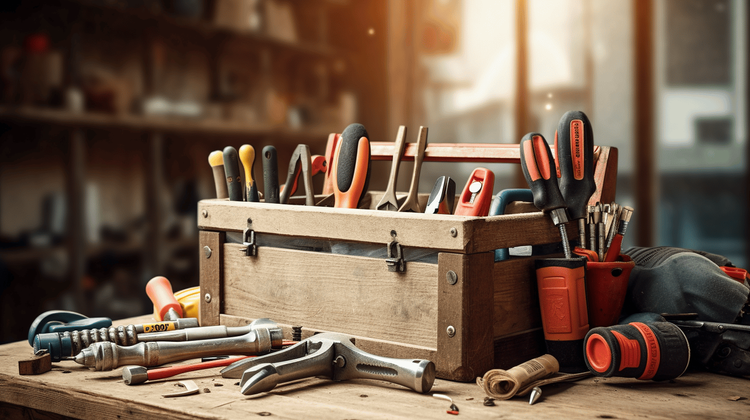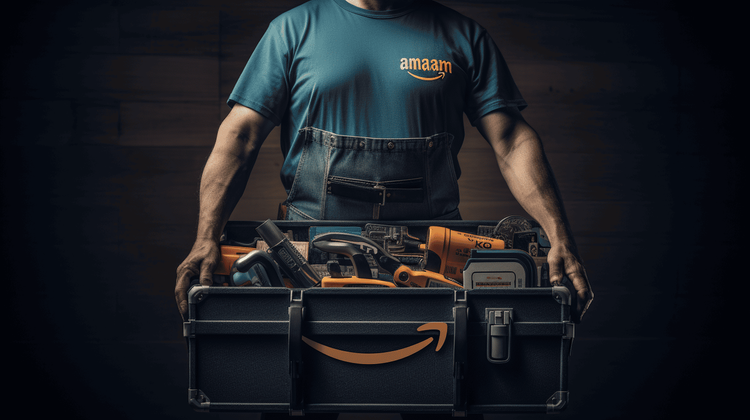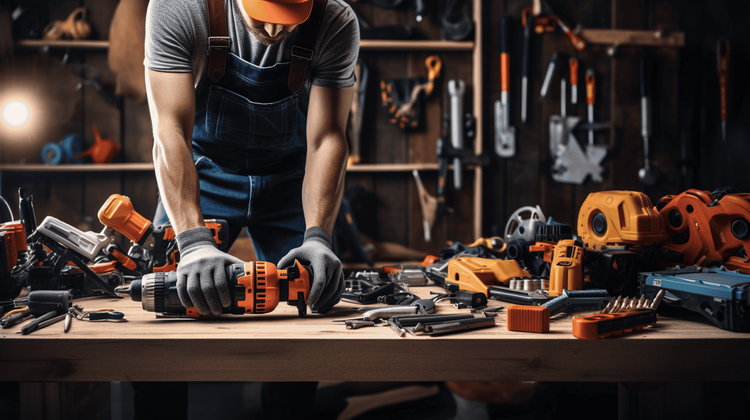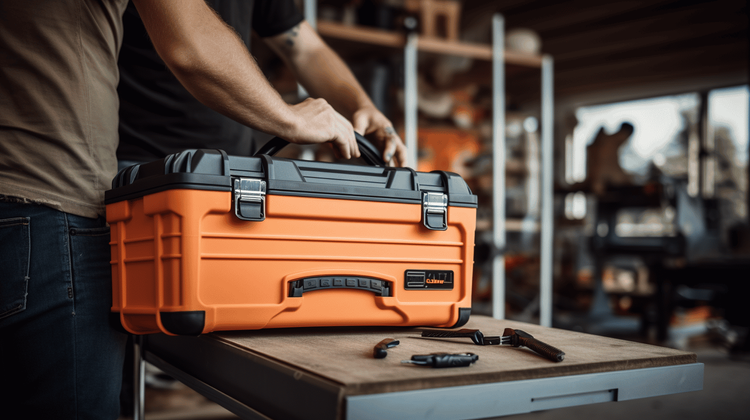Straight from the Expert: Affordable Tools for DIY Projects
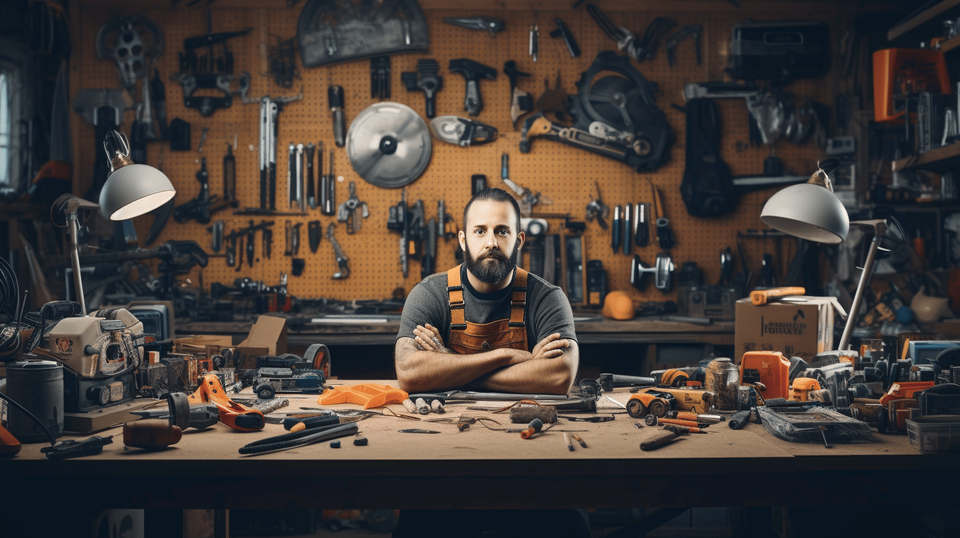
In the enchanting world of DIY, there's nothing more exhilarating than transforming a simple idea into a tangible achievement. Whether it's a home renovation, furniture assembly, or a gardening project - it all starts with the right set of tools. But let's face it! Not everyone has an overflowing budget to invest in expensive tools, nor is it necessary. This guide is your companion to discovering affordable, yet high-quality tools that can make your DIY journey, not just achievable, but enjoyable too. 🛠️ From power tools to hand tools, we'll also highlight how identifying the right tools, prioritizing safety, and maintaining them can lead to durable and efficient DIY results. So get ready, it's time to roll up your sleeves!
Why Affordable Tools Matter for DIY Projects
For many, the idea of diving into a DIY project can be as exhilarating as it is intimidating. The fear of incurring high costs on expensive tools often deters countless individuals from rolling up their sleeves and transforming their spaces. With the wide range of affordable tools available today, DIY just became a lot less daunting and a whole lot more practical. So why exactly do affordable tools matter for DIY projects? Let's find out.
Speaking in terms of economics, it's simple: the less you spend on tools, the more money left in your pocket for other expenses. Consider this: if you're redecorating a room and spend your entire budget on top-tier tools, you're left with nothing for fresh paint, new curtains, or that perfect vintage chair you spotted at the local thrift shop.
But it's not just budget-friendly implications; there are practical benefits too:
- Less Risk of Financial Loss: Affordable tools carry less financial risk. If you're a novice DIY-er and accidentally break a tool, replacing it won't cost you a fortune.
- Less Intimidating for Beginners: The daunting nature of prices on professional-grade tools can be off-putting. Affordable tools are less intimidating, encouraging more people to embrace the DIY spirit.
- Easier to Experiment With: The low cost allows you to experiment with different tools. Helpful, especially when you're not sure about the right tool for a job.
Moreover, affordable doesn't necessarily equate to low-quality. Many reputable brands manufacture impressive and reliable DIY tools that won't make a sizable dent in your budget. Just as you don't need a spaceship to reach the moon, you don't need the most expensive tools to create a masterpiece.
The English language is a tool itself, essential to communicate the process of a DIY project. You might need to read manuals or learn new terms, and a well-rounded understanding of the language comes in handy. Ease in understanding complex instructions helps you navigate any DIY project smoothly.
So, whether you’re a seasoned craftsperson or you’re a beginner who’s just starting their journey, buying affordable tools is a smart, wise, and cost-effective decision that can transform your entire DIY experience—change your perspective from "I wish I could do that" to "let me give it a try!" From both an investment and an empowerment standpoint, affordable tools truly make a difference. 🛠️ So, roll up your sleeves and enhance your passion for crafting with quality, yet inexpensive tools. Trust us, your wallet will thank you! 🙌
Types of Affordable Tools for DIY Projects
Are you a DIY enthusiast looking to expand your toolkit without breaking the bank? You're in luck because today, we'll dive headlong into the world of affordable tools for DIY projects. These tools don't merely get the job done; they add an effortless twinkle ✨ to all your creations, from home decor to garden art.
Hand Tools
Hand tools are the bread and butter 🍞 of any DIY tool kit. They are affordable, easy to use, and versatile. However, selecting the right ones can be challenging.
- Hammers: For a DIY beginner, a claw hammer can handle a multitude of tasks. It offers effortless nailing and swift nail removal.
- Screwdrivers: You may want to invest in both flat-head and Phillips screwdrivers. These types come in handy for tasks ranging from furniture assembly to electronic repairs.
- Pliers: These tools are all-stars ⭐ for tasks that require gripping, bending, or cutting wire.
- Wrenches: An adjustable wrench is versatile and ideal for tightening and loosening bolts of various sizes.
These tools are staples in any toolkit and can be bought without burning a hole in your pocket.
Power Tools
While hand tools are great, sometimes a project calls for a bit more firepower 🔥. Enter power tools. Now, these can be a bit more costly, but don't worry. There are affordable options out there that offer both value and versatility.
- Cordless Drill: This tool is essentially for drilling holes and driving screws.
- Jigsaw: Perfect for cutting shapes in wood and a variety of other materials.
- Circular Saw: This is a must-have for any woodworking project.
Remember to always practice safety when dealing with power tools. A small investment in safety gear can keep you protected while working on your projects.
Tool Accessories
Up your DIY game with practical and budget-friendly tool accessories. These add-ons make a world of difference in project execution and efficiency.
- Tape Measure: Accuracy is key in DIY projects. A good tape measure is invaluable.
- Utility Knife: From cutting tapes to opening boxes, the importance of a sharp utility knife can't be overstated.
- Toolbox: Keep your tools organized with a sturdy, portable toolbox.
In essence, your DIY arsenal doesn't need to empty your wallet. Affordable tools and accessories are accessible, and they can cater to a wide range of crafting, maintenance, and repair tasks around the house. Build your kit gradually, prioritizing essential tools first, and soon enough, you'll be the go-to DIY master in your circle. So, roll up your sleeves and let's get crafting! 🛠️
Identifying High-Quality, Affordable Tools
Everyone has experienced the frustration of a broken tool. Whether it's a hammer with a loose handle or a pair of garden shears that have gone dull, low-quality tools can lead to inefficiencies, damage, and even potential safety hazards. To avoid these problems, it's crucial to learn how to identify high-quality, affordable tools. Now, let's delve into this fascinating topic.
Material and Manufacturing
Consider the material used and the manufacturing process as a key initial step in determining the quality of a tool. High-quality tools are usually crafted from robust materials such as stainless steel, aluminium, or impact-resistant plastics depending on the nature of the tool at hand. Furthermore, a well-manufactured tool feels solid and balanced in the hand, with no wobble or weakness observed in joints and connections.
- High carbon steel is ideal for cutting tools while composite materials suit general purpose tools.
- Manufacturing with finesse leads to robust, long-lasting tools.

Tool Functionality
Functional efficiency also plays an important role. This not only applies to the basic function of the tool, but how it performs when in use. Consider how the tool feels in your hand, or if it causes strain when used over time. Look for tools that feature ergonomic design, which can decrease user fatigue, and have built-in safety features.
"The right tool doesn't feel like a brick in your hand, it feels like an extension of your arm."
Brand Reputation
Don't underestimate the importance of brand reputation. Brands that have been around for several years usually have a wealth of customer reviews that can help you in identifying high-quality, affordable tools. In the tool world, brand reputation matters; it often speaks volumes about the company's commitment towards quality and customer service.
📣 Remember, a good brand doesn't always mean expensive. Many brands offer top-notch tools at a reasonable price.
Online and In-Store Pricing
Finally, it's crucial to compare online and in-store prices. Sometimes, you might find better deals online due to competitive pricing or flash sales. However, it's also essential to factor in shipping costs, which can push the total cost higher than you might find in-store. Be sure to check for warranties or guarantees, as these can offer additional peace of mind when purchasing tools.
Making an informed decision when purchasing tools requires consideration of various factors. Not only must you consider the materials, manufacturing, brand reputation, and price, but also prioritize your comfort and safety. So, the next time you're eyeing a new tool - keep these tips handy and you'll certainly make a fine choice! 💼🛠️
Safety Considerations When Choosing Tools
When it comes to selecting the right tools for any job, safety considerations should always be at the forefront. An often overlooked aspect of tool selection, prioritizing safety not only protects the user, but ensures smoother and more efficient operations. After all, the right tools in safe hands can make all the difference.
Now, let's delve deeper into the aspects that make a tool safer than the rest.
Tool Durability
Heavy-duty jobs call for tools that are built to last. If a tool isn't sturdy or robust enough, there's always a possibility of it breaking or malfunctioning during use. Not only can this halt your project, but it could also lead to serious injuries. Therefore, always opt for tools that have a proven track record of durability.
Here are a few things to look out for:
- Material: Ensure the tool is made from high-quality, robust material such as stainless steel or hardened plastic.
- Construction: Well-constructed tools often feature seamless construction or rugged welds.
- Guarantee: Tools from reputable manufacturers often come with a guarantee, which is a testament to their durability.
Safety Features
In addition to durability, it's essential to check if a tool comes equipped with adequate safety features. These can include everything from secure grips to safety switches, which can forestall common accidents at the workplace or at home.
Keep an eye out for these features:
- Non-slip Handles: These provide a secure grip, reducing the chances of slipping and subsequent injuries.
- Safety Switches: These prevent accidental startups, keeping the user safe.
- Shield Guards: Essential for cutting tools, these guards protect hands from potentially severe cuts.
Proper Tool Use
Regardless of how safe a tool claims to be, it all ultimately boils down to how it's used. Even the most durable tools with advanced safety features can't keep you safe if not used correctly. Knowing how to handle and maintain your tools is just as crucial as selecting the right ones.
Here are a few things to keep in mind:
- Always read the user manual before beginning.
- Regularly inspect your tools for any wear and tear.
- Avoid using tools for tasks they aren't designed to perform.
- Keep your work area clean and uncluttered.
Remember, your safety hinges largely on the selections you make. So, when it comes to picking the best tools, never compromise on safety standards. Even if it means spending a bit more, the peace of mind and reduced risk of injury or damage make it a worthy investment. After all, as the wise saying goes, "Safety isn't expensive, it's priceless." 🛠⚠️💪
Recommended Affordable Tools for Popular DIY Projects
When it comes to tackling DIY projects, having the right tools in your arsenal can significantly increase the probability of success, not to mention boosting the enjoyment factor. Whether you’re assembling furniture, undergoing home repairs, or keeping your garden in prime condition, each task demands its own set of dedicated tools. And let's not forget the satisfaction of wielding your tools with confidence - that's a feeling money can't buy! 💪
Still, finding the right tools at an affordable price can feel like a quest for the Holy Grail. Not to worry, though, because we’ve got you covered. Here are some cost-effective tool essentials guaranteed to elevate your DIY game.
Furniture Assembly
Furniture assembly can transform from a daunting task into a rewarding exercise with the right utilities. Investing in a high-quality toolbox will often provide you with the basic necessities you’ll need for this art. Some of the fundamental tools for furniture assembly include:
- Screwdriver Sets: Seek out sets that offer a variety of shapes and sizes. They will come in handy when working with different types of screws.
- An Allen Wrench: This simple tool (also known as a hex key) is crucial for virtually any furniture assembly project.
- A Rubber Mallet: A mallet can help you protect the furniture surface while still applying the required force.
Home Repair and Renovations
Rolling up your sleeves and diving into home repairs and renovations can be a fulfilling adventure! Here are a few basics you might not think of at first but which will immensely assist in your DIY journey.
- A Cordless Drill: For that perpetual and mighty "screwing and unscrewing", this gadget is worth every penny!
- A Level: This tool is an unsung hero when it comes to renovations. It can help ensure your shelves, frames, and more are flawlessly straight.
- A stud finder: This tool will help you locate studs behind the wall, crucial when hanging heavy items securely.
Gardening and Outdoor Work
Green thumbs, or those aspiring to acquire one, will find these tools advantageous for gardening and outdoor work. They can help transform your backyard into a tranquil oasis.
- A Garden Trowel: Ideal for planting flowers or for digging small holes.
- Pruning Shears: Pruning shears are a must-have for keeping your plants healthy and aesthetically pleasing.
- A Rake: Unlike its autumn foliage gathering capabilities, a rake is also an efficient tool for aeration, which helps improve soil and overall plant health.
In the world of DIY projects, your tools are your trusty sidekicks. Take your time picking out reasonably priced-quality tools that best suit your needs, and remember that they're an investment! Time to sharpen your DIY skills and conquer that project list! Good luck, and happy DIY-ing! 🛠️
Care and Maintenance of Tools
We all have that toolkit at home that we dip into for the odd jobs around the house: assembling a piece of furniture, repairing a loose handle or perhaps tackling that DIY project that's been on the to-do list for ages. What's often overlooked, however, is the importance of the care and maintenance of these tools. It's not just about getting the best performance from them, but it also ensures they have a longer lifespan and keeps us safe while using them. Let's delve into the finer details of tool care and learn how simple steps like cleaning, proper storage, and periodic maintenance checks can help your tools serve you longer and better.
Cleaning
After a hard day's work, your tools may end up covered in dirt, dust, and grime. But don't worry, giving your tools a good clean doesn't have to be a daunting task if done regularly. Here are some simple steps to keep your tools shiny and efficient:
- Wipe clean: Use a clean, dry cloth to wipe off any dust or dirt after every use.
- Degrease: For tools that have layered grease or heavy dirt, use a degreaser.
- Dry thoroughly: Ensure all tools are completely dry to prevent rust.
"A clean tool is a happy tool!"
Storage
Proper storage of tools is not just about keeping your workspace tidy; it has a major impact on the lifespan and safety of your tools. Think about these tips the next time you put your tools away:
- Use a Toolbox or Chest: These are designed to keep tools from touching and potentially damaging each other.
- Keep Them Dry: Moist environments can lead to rust and corrosion. Consider using silica gel packets to combat humidity.
- Organize by Usage: Keep the tools you use most often within easy reach.
Periodic Maintenance Checks
While cleaning and storage are essential steps, periodic maintenance checks are the true secret to keeping your tools in tip-top shape. These involve a more thorough inspection of your tools, addressing any underlying issues:
- Check for Wear and Tear: Regularly inspect your tools for any signs of damage, including cracks, bluntness or rust.
- Lubricate: Apply lubricant to any moving parts to ensure smooth operation and prevent rust.
- Timely Replacement: If a tool is beyond repair or presents a safety risk, it's time for a replacement.
In the end, It's all about giving your tools the same level of care they provide to you. Remember, with proper cleaning, strategic storage, and routine maintenance checks, your tools will reward you with an effective performance and an incredibly extended lifespan. Remember the golden rule: take care of your tools and they'll take care of you! +1 for tool care! 🙌
Conclusion
DIY projects shouldn't break the bank nor compromise on quality tools. With keen discernment of the right tools and proper care, one can embark on numerous worthwhile projects, creating personal and monetary value. By prioritizing aspects like tool functionality, safety features, and material strength, the journey towards becoming a seasoned DIY expert is less daunting and more rewarding.
Remember that knowledge goes hand in hand with the right set of tools. Let's picture the Ultra Handy Bit Holder Keychain – an affordable yet high-quality tool that exemplifies excellent functionality and ease of use. Such gadgets can genuinely simplify a wide array of DIY tasks and help users get one step closer to professional results.
Above all, remember that care and maintenance of your tools play a crucial role in ensuring their shelf life, saving replacement costs in the long run. From cleaning to storage to periodic checks, your tools need TLC to perform their best when you need them most.
Embrace your DIY spirit. Take that bold step forward and invest in affordable, quality tools. With the right choices, not only can you meet the needs of any project, but you can also add to your life's successes – one DIY project at a time.
Frequently Asked Questions
- What are some affordable tools for DIY projects?Some affordable tools for DIY projects include a basic toolkit consisting of a hammer, screwdrivers, pliers, measuring tape, and utility knife. Other affordable tools include a power drill, level, wrench set, and a saw.
- Where can I find affordable tools for DIY projects?You can find affordable tools for DIY projects at local hardware stores, home improvement centers, and online marketplaces like Amazon and eBay. Additionally, consider checking out garage sales, thrift stores, and classified ads for used tools at lower prices.
- Are cheap tools of low quality?Not all cheap tools are low quality. While some inexpensive tools may not be as durable or have advanced features, many affordable options offer decent quality and functionality for DIY projects. It's important to read reviews, compare specifications, and choose reputable brands for better assurance of quality.
- What are the essential power tools for DIY projects?Some essential power tools for DIY projects include a power drill, circular saw, jigsaw, and orbital sander. These tools are versatile and can help you accomplish a wide range of projects efficiently.
- Are there any free alternatives to expensive tools?Yes, there are often free alternatives to expensive tools. For example, instead of buying expensive clamps, you can use heavy books or large binder clips. Online tutorials and DIY communities often provide innovative hacks and substitutes for costly tools.
